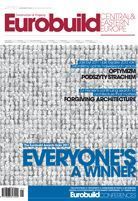Mladen Petrov, 'Eurobuild CEE': What's your first memory of thinking about buildings?Zvi Hecker, architect: It's very simple. Between the ages of 11 and 14, during the Second World War, I was in Samarkand in Uzbekistan, and the art teacher was an architecture student who couldn't finish his studies due to the war. He was very skilled at drawing. In the afternoons he would take me to draw the ruins of the incredible Islamic architecture in Samarkand. After a couple of years, by the age of 14, I could say that I was already an architect - even though I didn't know it yet.
What were your parents like? Did they also have a thing for art, an eye for beauty?I don't come from a strictly artistic family. My father was a lawyer, but it was my mother who was the one with the artistic touch. My family owned a bakery, actually the biggest one in Kraków. So we made bread for a living and for me bread represents the best of innovation. I am fascinated with bread - how flour, which we cannot eat, i






























































